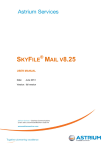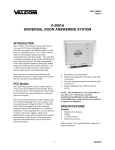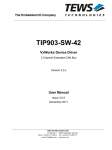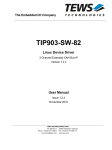Download TPMC901-SW-72 - powerbridge.de
Transcript
The Embedded I/O Company TPMC901-SW-72 LynxOS Device Driver 6 / 4 / 2 Channel Extended CAN bus PMC Version 1.0 User Manual Issue 1.1 March 2004 TEWS TECHNOLOGIES GmbH Am Bahnhof 7 Phone: +49-(0)4101-4058-0 e-mail: [email protected] 25469 Halstenbek / Germany Fax: +49-(0)4101-4058-19 www.tews.com TEWS TECHNOLOGIES LLC 1 E. Liberty Street, Sixth Floor Phone: +1 (775) 686 6077 e-mail: [email protected] Reno, Nevada 89504 / USA Fax: +1 (775) 686 6024 www.tews.com TPMC901-SW-72 6 / 4 / 2 Channel Extended CAN bus PMC LynxOS Device Driver This document contains information, which is proprietary to TEWS TECHNOLOGIES GmbH. Any reproduction without written permission is forbidden. TEWS TECHNOLOGIES GmbH has made any effort to ensure that this manual is accurate and complete. However TEWS TECHNOLOGIES GmbH reserves the right to change the product described in this document at any time without notice. TEWS TECHNOLOGIES GmbH is not liable for any damage arising out of the application or use of the device described herein. 2001-2004 by TEWS TECHNOLOGIES GmbH Issue Description Date 1.0 First Issue April 2001 1.1 General Revision March 2004 TPMC901-SW-72 - LynxOS Device Driver Page 2 of 44 Table of Contents 1 2 INTRODUCTION......................................................................................................... 4 INSTALLATION.......................................................................................................... 5 2.1 Device Driver Installation ...............................................................................................................5 2.1.1 Static Installation...................................................................................................................5 2.1.1.1 Build the Driver Object..................................................................................................6 2.1.1.2 Create Device Information Declaration ........................................................................6 2.1.1.3 Modify the Device and Driver Configuration File..........................................................6 2.1.1.4 Rebuild the Kernel ........................................................................................................6 2.1.2 Dynamic Installation..............................................................................................................7 2.1.3 Device Information Definition File.........................................................................................8 2.1.4 Configuration File: CONFIG.TBL..........................................................................................9 2.2 Receive Queue Configuration......................................................................................................10 3 DEVICE DRIVER PROGRAMMING ......................................................................... 11 3.1 3.2 3.3 3.4 3.5 4 open() .............................................................................................................................................11 close().............................................................................................................................................13 read() ..............................................................................................................................................14 write() .............................................................................................................................................17 ioctl() ..............................................................................................................................................20 3.5.1 TP901_BITTIMING .............................................................................................................22 3.5.2 TP901_SETFILTER............................................................................................................24 3.5.3 TP901_GETFILTER ...........................................................................................................26 3.5.4 TP901_BUSON ..................................................................................................................28 3.5.5 TP901_BUSOFF.................................................................................................................29 3.5.6 TP901_FLUSH ...................................................................................................................30 3.5.7 TP901_DEFRXBUF............................................................................................................31 3.5.8 TP901_DEFRMTBUF .........................................................................................................34 3.5.9 TP901_UPDATEBUF .........................................................................................................36 3.5.10 TP901_RELEASEBUF .....................................................................................................39 3.5.11 TP901_CANSTATUS .......................................................................................................41 DEBUGGING AND DIAGNOSTIC............................................................................ 42 TPMC901-SW-72 - LynxOS Device Driver Page 3 of 44 1 Introduction The TPMC901-SW-72 LynxOS device driver allows the operation of the TPMC901, a 6/4/2 Channel Extended CAN bus PMC on a PowerPC platform with DRM based PCI interface. The standard file (I/O) functions (open, close, read, write and ioctl) provide the basic interface for opening and closing a file descriptor and for performing device I/O and control operations. The TPMC901 device driver includes the following functions: ! ! ! ! ! ! Transmission and receive of Standard and Extended Identifiers Up to 15 receive message queues with user defined size Variable allocation of receive message objects to receive queues Standard bit rates from 5 kbit up to 1.6 Mbit and user defined bit rates Message acceptance filtering Definition of receive and remote buffer message objects To understand all features of this device driver, it is very important to read the Architectural Overview of the Intel 82527 CAN controller, which is part of the Engineering Documentation TPMC901-ED. In case of difficulties during driver installation please contact TEWS TECHNOLOGIES. TPMC901-SW-72 - LynxOS Device Driver Page 4 of 44 2 Installation The software is delivered on a PC formatted 3½" HD diskette. The directory A:\TPMC901-SW-72 contains the following files: TPMC901-SW-72.pdf TPMC901-SW-72.tar This manual in PDF format Device Driver and Example sources The TAR archive TPMC901-SW-72.tar contains the following files and directories: tpmc901.c tpmc901.h tpmc901def.h i82527.h tpmc901_info.c tpmc901_info.h tpmc901.cfg tpmc901.import Makefile Makefile.dldd example/example.c tpmc901-sw-72.pdf Driver source code Definitions and data structures for driver and application Definitions and data structures for the driver Extended CAN controller programming model Device information definition Device information definition header Driver configuration file include Linker import file Device driver make file Make file for dynamic driver installation Example application source This manual in PDF format In order to perform a driver installation first extract the TAR file to a temporary directory then copy the following files to their target directories. 2.1 Device Driver Installation The two methods of driver installation are as follows: • Static installation • Dynamic installation (only native LynxOS systems) 2.1.1 Static Installation With this method, the driver object code is linked with the kernel routines and is installed during system start-up. In order to perform a static installation, copy the following files to the target directories: 1. Create a new directory in the system drivers directory path. For example: /sys/drivers.pp_drm/tpmc901 2. Copy the following files to this directory: tpmc901.c, tpmc901def.h, i82527.h, Makefile 3. Copy tpmc901.h to /usr/include/ 4. Copy tpmc901_info.c to /sys/devices/ TPMC901-SW-72 - LynxOS Device Driver Page 5 of 44 5. Copy tpmc901_info.h to /sys/dheaders/ 6. Copy tpmc901.cfg to /sys/cfg.ppc/ 2.1.1.1 Build the Driver Object 1. Change to the directory /sys/drivers.pp_drm/tpmc901. 2. To update the library /sys/lib/libdrivers.a enter: make install 2.1.1.2 Create Device Information Declaration 1. Change to the directory /sys/devices/ 2. Add the following dependencies to the Makefile: DEVICE_FILES_prep = ... tpmc901_info.x And at the end of the Makefile: 3. ... tpmc901_info.o:$(DHEADERS)/tpmc901_info.h To update the library /sys/lib/libdevices.a enter: make install 2.1.1.3 Modify the Device and Driver Configuration File In order to insert the driver object code into the kernel image, an appropriate entry in file CONFIG.TBL must be created. 1. Change to the directory /sys/lynx.os/ 2. Create an entry in the file CONFIG.TBL. Insert the entry after the console driver section: # End of console devices I:tpmc901.cfg 2.1.1.4 Rebuild the Kernel 1. Change to the directory /sys/lynx.os/ (/sys/bsp.pp_drm) 2. Enter the following command to rebuild the kernel: 3. make install Reboot the newly created operating system by the following command: reboot –aN The N flag instructs init to run mknod and create all the nodes mentioned in the new nodetab. 4. After reboot the following new devices should be find (depends on the device configuration): /dev/tp9016a1, [ /dev/tp901a2, …] TPMC901-SW-72 - LynxOS Device Driver Page 6 of 44 2.1.2 Dynamic Installation This method allows installing the driver after the operating system is booted. The driver object code is attached to the end of the kernel image and the operating system dynamically adds this driver to its internal structures. The driver can also be removed dynamically. Unlike the description of the dynamic installation in the manual “Writing Device Drivers for LynxOS”, the driver source must be placed in a directory under /sys/drivers.pp_drm/. The following steps describe how to do a dynamic installation: 1. Create a new directory in the system driver directory path. For example: /sys/drivers.pp_drm/tpmc901 2. Copy the following files to this directory: - tpmc901.c - tpmc901def.h - i82527.h - tpmc901_info.c - tpmc901_info.h - tpmc901.import - Makefile.dldd 3. Copy tpmc901.h to /usr/include 4. Change to the directory /sys/drivers.pp_drm/tpmc901 5. To make the dynamic link-able driver enter: 6. make –f Makefile.dldd Create a device definition file for one major device: 7. gcc –DDLDD –o tpmc901_info tpmc901_info.c ./tpmc901_info > tp901a_info To install the driver enter: drinstall –c tpmc901.obj If successful drinstall returns a unique <driver-ID> 8. To install the major device enter: devinstall –c –d <driver-ID> tp901a_info The <driver-ID> is returned by the drinstall command 9. To create nodes for the devices enter: mknod /dev/tp901a1 c <major_no> 0 ... If all steps are successful completed the TPMC901 is ready to use. To uninstall the TPMC901 device enter the following commands: devinstall –u –c <device-ID> drinstall –u <driver-ID> TPMC901-SW-72 - LynxOS Device Driver Page 7 of 44 2.1.3 Device Information Definition File The device information definition contains information necessary to install the TPMC901 major device. The implementation of the device information definition is done through a C structure, which is defined in the header file tpmc901_info.h. This structure contains the following parameter: PCIBusNumber Contains the PCI bus number at which the TPMC901 is connected. Valid bus numbers are in range from 0 to 255. PCIDeviceNumber Contains the device number (slot) at which the TPMC901 is connected. Valid device numbers are in range from 0 to 31. If both PCIBusNumber and PCIDeviceNumber are –1 then the driver will auto scan for the TPMC901 device. The first device found in the scan order will be allocated by the driver for this major device. Already allocated devices can’t be allocated twice. This is important to know if there are more than one TMPC901 major devices. A device information definition is unique for every TPMC901 major device. The file tpmc901_info.c on the distribution disk contains two device information declarations, tp901a_info for the first major device and tp901b_info for the second major device. If the driver should support more than two major devices it is necessary to copy and paste an existing declaration and rename it with unique name for example tp901c_info, tp901d_info and so on. It is also necessary to modify the device and driver configuration file respectively the configuration include file tpmc901.cfg. The following device declaration information uses the auto find method to detect the TPMC901 module on PCI bus. TP901_INFO tp901a_info = { -1, -1, /* Auto find the TPMC901 on any PCI bus */ }; TPMC901-SW-72 - LynxOS Device Driver Page 8 of 44 2.1.4 Configuration File: CONFIG.TBL The device and driver configuration file CONFIG.TBL contains entries for device drivers and its major and minor device declarations. Each time the system is rebuild, the config utility reads this file and produces a new set of driver and device configuration tables and a corresponding nodetab. To install the TPMC901 driver and devices into the LynxOS system, the configuration include file tpmc901.cfg must be included in the CONFIG.TBL (see also chapter “Modify the Device and Driver Configuration File”). The file tpmc901.cfg on the distribution disk contains the driver entry (C:tpmc901:\....) and one enabled major device entry (D:TPMC901 1:tp901a_info::) with six minor device entries (N: tp901a1:0… N:tp901a6:5). If the driver should support more than one major device the following entries for major and minor devices must be enabled by removing the comment character (#). By copy and paste an existing major and minor entry and renaming the new entries, it is possible to add any number of additional TPMC901 devices. The name of the device information declaration (info-block-name) must match to an existing C structure in the file tpmc901_info.c. This example shows a driver entry with one major device and 6 minor devices: # # # # Format: C:driver-name:open:close:read:write:select:control:install:uninstall D:device-name:info-block-name:raw-partner-name N:node-name:minor-dev C:tpmc901:\ :tp901open:tp901close:tp901read:tp901write:\ ::tp901ioctl:tp901install:tp901uninstall D:TPMC901 1:tp901a_info:: N:tp901a1:0 N:tp901a2:1 N:tp901a3:2 N:tp901a4:3 N:tp901a5:4 N:tp901a6:5 The configuration above creates the following node in the /dev directory. /dev/tp901a1 /dev/tp901a2 /dev/tp901a3 /dev/tp901a4 /dev/tp901a5 /dev/tp901a6 TPMC901-SW-72 - LynxOS Device Driver Page 9 of 44 2.2 Receive Queue Configuration Received CAN messages will be stored in receive queues. Each receive queue contains a FIFO. The number of receive queues and the depth of the FIFO can be adapted by changing the following symbols in tpmc901def.h. NUM_RX_QUEUES Defines the number of receive queues for each device (default = 3). Valid numbers are in range between 1 and 15. RX_FIFO_SIZE Defines the depth of the message FIFO inside each receive queue (default = 100). Valid numbers are in range between 1 and MAXINT. TPMC901-SW-72 - LynxOS Device Driver Page 10 of 44 3 Device Driver Programming LynxOS system calls are all available directly to any C program. They are implemented as ordinary function calls to "glue" routines in the system library, which trap to the OS code. Note that many system calls use data structures, which should be obtained in a program from appropriate header files. Necessary header files are listed with the system call synopsis. 3.1 open() NAME open() opens a file. SYNOPSIS #include <sys/file.h> #include <sys/types.h> #include <fcntl.h> int open ( char *path, int oflags[, mode_t mode] ) DESCRIPTION Opens a file (TPMC901 device) named in path for reading and writing. The value of oflags indicates the intended use of the file. In case of a TPMC901 devices oflags must be set to O_RDWR to open the file for both reading and writing. The mode argument is required only when a file is created. Because a TPMC901 device already exists this argument is ignored. EXAMPLE int /* ** */ fd Open the device named "/dev/tp901a1" for I/O fd = open ("/dev/tp901a1", O_RDWR); TPMC901-SW-72 - LynxOS Device Driver Page 11 of 44 RETURNS If successful open returns a file descriptor number or in case of an error returns -1. SEE ALSO LynxOS System Call - open() TPMC901-SW-72 - LynxOS Device Driver Page 12 of 44 3.2 close() NAME close() closes a file. SYNOPSIS int close( int fd ) DESCRIPTION This function closes an opened device. EXAMPLE int result; /* ** Close the device */ result = close(fd); RETURNS If successful close returns 0 (OK) or in case of an error returns -1. SEE ALSO LynxOS System Call - close() TPMC901-SW-72 - LynxOS Device Driver Page 13 of 44 3.3 read() NAME read() reads from a file. SYNOPSIS #include <tpmc901.h> int read ( int fd, char *buff, int count ) DESCRIPTION The read function reads a CAN message from the specified receive queue. A pointer to the caller’s message buffer (TP901_MSG_BUF) and the size of this structure is passed by the parameters buff and count to the device. The TP901_MSG_BUF structure has the following layout: typedef struct { unsigned long long unsigned char unsigned char unsigned char unsigned char unsigned char Identifier; Timeout; RxQueueNum; Extended; Status; MsgLen; Data[8]; } TP901_MSG_BUF, *PTP901_MSG_BUF; Identifier Parameter receives the message identifier of the read CAN message. Timeout Parameter specifies the amount of time (in ticks) the caller will wait for execution of read. RxQueueNum Parameter specifies the receive queue number from which the data will be read. Valid receive queue numbers are in range between 1 and n. In which n depends on the definition of NUM_RX_QUEUES (see also chapter “Receive Queue Configuration”). TPMC901-SW-72 - LynxOS Device Driver Page 14 of 44 Extended Parameter receives TRUE for extended CAN messages. Status Parameter receives status information about overrun conditions either in the CAN controller or intermediate software FIFO’s. TP901_SUCCESS No messages lost TP901_FIFO_OVERRUN One or more messages were overwritten in the receive queue FIFO. This problem occurs if the FIFO is too small for the application read interval. TP901_MSGOBJ_OVERRUN One or more messages were overwritten in the CAN controller message object because the interrupt latency is too large. Use message object 15 (buffered) to receive this time critical CAN messages, reduce the CAN bit rate or upgrade the system speed. MsgLen Parameter receives the number of message data bytes (0..8). Data[8] This buffer receives up to 8 data bytes. Data[0] receives message Data 0, Data[1] receives message Data 1 and so on. EXAMPLE int int TP901_MSG_BUF fd; result; MsgBuf; ... MsgBuf.RxQueueNum MsgBuf.Timeout = 1; = 200; result = read(fd, (char*)&MsgBuf, sizeof(MsgBuf)); /* ** */ Check the result of the last device I/O operation if( result == sizeof(TP901_MSG_BUF)) { /* Process received CAN message */ } else { printf( "\nRead failed --> Error = %d.\n", errno ); } ... TPMC901-SW-72 - LynxOS Device Driver Page 15 of 44 RETURNS When read succeeds, the size of the read buffer is returned. If read fails, -1 (SYSERR) is returned. On error, errno will contain a standard read error code (see also LynxOS System Call – read) or one of the following TPMC901 specific error codes: ENXIO Illegal device EINVAL Invalid argument. This error code is returned if either the size of the message buffer is too small, or the specified receive queue is out of range. ETIMEDOUT The maximum allowed time to finish the read request is exhausted. ENETDOWN The controller is in bus off state and no message is available in the specified receive queue. As long as CAN messages are available in the receive queue FIFO, bus off conditions were not reported by a read function. This means all CAN messages can be read out of the receive queue FIFO during bus off state without an error result. SEE ALSO LynxOS System Call - read() TPMC901-SW-72 - LynxOS Device Driver Page 16 of 44 3.4 write() NAME write() writes to a file. SYNOPSIS int write ( int fd, char *buff, int count ) DESCRIPTION The write function writes a CAN message to the device with descriptor fd. A pointer to the caller’s message buffer (TP901_MSG_BUF) and the size of this structure is passed by the parameters buff and count to the device. The write function dynamically allocates a free message object for this transmit operation. The search begins at message object 1 and ends at message object 14. The first found free message object is used. If no message object is available the write operation returns with error. If application performs write operations at least one message object should be left free for transmit, preferably the first message object. The TP901_MSG_BUF structure has the following layout: typedef struct { unsigned long long unsigned char unsigned char unsigned char unsigned char unsigned char Identifier; Timeout; RxQueueNum; Extended; Status; MsgLen; Data[8]; } TP901_MSG_BUF, *PTP901_MSG_BUF; Identifier Parameter contains the message identifier of the CAN message to write. Timeout Parameter specifies the amount of time (in ticks) the caller will wait for execution of write. RxQueueNum Parameter is unused for this control function. It can be 0. Extended Parameter contains TRUE (1) for extended CAN messages. TPMC901-SW-72 - LynxOS Device Driver Page 17 of 44 Status Parameter is unused for this control function. It can be 0. MsgLen Parameter contains the number of message data bytes (0..8). Data[8] This buffer contains up to 8 data bytes. Data[0] contains message Data 0, Data[1] contains message Data 1 and so on. EXAMPLE int fd; int result; TP901_MSG_BUF MsgBuf; ... /* ** Write two data bytes with identifier 1234 to the ** CAN bus and wait max. 200 ticks on execution */ MsgBuf.Identifier MsgBuf.Timeout MsgBuf.Extended MsgBuf.MsgLen MsgBuf.Data[0] MsgBuf.Data[1] = = = = = = 1234; 200; TRUE; 2; 0xaa; 0x55; result = write(fd, &MsgBuf, sizeof(MsgBuf)); if( result != sizeof(TP901_MSG_BUF)) { printf( "\nWrite failed --> Error = %d.\n", errno ); } ... TPMC901-SW-72 - LynxOS Device Driver Page 18 of 44 RETURNS When write succeeds, the size of the write buffer is returned. If write fails, -1 (SYSERR) is returned. On error, errno will contain a standard write error code (see also LynxOS System Call – write) or the following TPMC901 specific error code: ENXIO Illegal device EINVAL Invalid argument. This error code is returned if the size of the message buffer is too small. ENOSPC No free message object available for transmit ENETDOWN The controller is in bus off state and unable to transmit messages. ETIMEDOUT The allowed time to finish the write request is elapsed. This occurs if the CAN bus is overloaded and the priority of the message identifier is too low, no other node is online or the controller enters the bus off state. SEE ALSO LynxOS System Call - write() TPMC901-SW-72 - LynxOS Device Driver Page 19 of 44 3.5 ioctl() NAME ioctl() I/O device control SYNOPSIS #include <ioctl.h> #include <tpmc901.h> int ioctl ( int fd, int request, char *arg ) DESCRIPTION ioctl provides a way of sending special commands to a device driver. The call sends the value of request and the pointer arg to the device associated with the descriptor fd. The following ioctl codes are defined in TPMC901.h : Value Meaning TP901_BITTIMING Setup a new bit timing TP901_SETFILTER Setup acceptance filter masks TP901_GETFILTER Get the current acceptance filter masks TP901_BUSON Enter the bus on state TP901_BUSOFF Enter the bus off state TP901_FLUSH Flush one or all receive queues TP901_CANSTATUS Returns the contents of the CAN Controller Status Register TP901_DEFRXBUF Define a receive buffer message object TP901_DEFRMTBUF Define a remote transmit buffer message object TP901_UPDATEBUF Update a remote or receive buffer message object TP901_RELEASEBUF Release an allocated message buffer object See below for more detailed information on each control code. TPMC901-SW-72 - LynxOS Device Driver Page 20 of 44 RETURNS If successful ioctl returns 0 or in case of an error returns -1. The TPMC901 ioctl function returns always standard error codes. See LynxOS system call ioctl for a detailed description of possible error codes. ERRORS LynxOS System Call - ioctl() TPMC901-SW-72 - LynxOS Device Driver Page 21 of 44 3.5.1 TP901_BITTIMING NAME TP901_BITTIMING sets up new bit timing. DESCRIPTION This ioctl function modifies the bit timing register of the CAN controller to setup a new CAN bus transfer speed. A pointer to the caller's parameter buffer (TP901_TIMING) is passed by the argument pointer arg to the driver. Keep in mind to setup a valid bit timing value before changing into the bus on state. The TP901_TIMING structure has the following layout: typedef struct { unsigned short unsigned short TimingValue; TreeSamples; } TP901_TIMING, *PTP901_TIMING; Timing Value Parameter holds the new values for the bit timing register 0 (bit 0..7) and for the bit timing register 1 (bit 8..15). Possible transfer rates are between 5 Kbit per second and 1.6 Mbit per second. The include file tpmc901.h contains predefined transfer rate symbols (TP901_5KBIT .. TP901_1_6MBIT). For other transfer rates please follow the instructions of the Intel 82527 Architectural Overview, which is also part of the Engineering Documentation TPMC901-ED. ThreeSamples If this parameter is TRUE (1) the CAN bus is sampled three times per bit time instead of one. Use one sample point for faster bit rates and three sample points for slower bit rate to make the CAN bus more immune against noise spikes. TPMC901-SW-72 - LynxOS Device Driver Page 22 of 44 EXAMPLE { int int TP901_TIMING fd; result; BitTimingParam; . . . BitTimingParam.TimingValue BitTimingParam.ThreeSamples = TP901_100KBIT; = FALSE; result = ioctl(fd, TP901_BITTIMING, (char*)&BitTimingParam); if (result < 0) { /* Handle ioctl error */ } . . . } SEE ALSO tpmc901.h for predefined bus timing constants Intel 82527 Architectural Overview - 4.13 Bit Timing Overview TPMC901-SW-72 - LynxOS Device Driver Page 23 of 44 3.5.2 TP901_SETFILTER NAME TP901_SETFILTER sets up acceptance filter masks. DESCRIPTION This ioctl function modifies the acceptance filter masks of the specified CAN controller device. The acceptance masks allow message objects to receive messages with a larger range of message identifiers instead of just a single message identifier. A "0" value means "don't care" or accept a "0" or "1" for that bit position. A "1" value means that the incoming bit value "must-match" identically to the corresponding bit in the message identifier. A pointer to the caller's parameter buffer (TP901_ACCEPT_MASKS) is passed by the parameter pointer arg to the driver. The TP901_ACCEPT_MASKS structure has the following layout: typedef struct { unsigned long unsigned long unsigned short Message15Mask; GlobalMaskExtended; GlobalMaskStandard; } TP901_ACCEPT_MASKS, *PTP901_ACCEPT_MASKS; Message15Mask Parameter specifies the value for the Message 15 Mask Register. The Message 15 Mask Register is a local mask for message object 15. This 29 bit identifier mask appears in bit 3..31 of this parameter. The Message 15 Mask is "ANDed" with the Global Mask. This means that any bit defined as "don't care" in the Global Mask will automatically be a "don't care" bit for message 15 (see also Intel 82527 Architectural Overview). GlobalMaskExtended Parameter specifies the value for the Global Mask-Extended Register. The Global Mask-Extended Register applies only to messages using the extended CAN identifier. This 29 bit identifier mask appears in bit 3..31 of this parameter. GlobalMaskStandard Parameter specifies the value for the Global Mask-Standard Register. The Global Mask-Standard Register applies only to messages using the standard CAN identifier. The 11 bit identifier mask appears in bit 5..15 of this parameter. The TPMC901 device driver copies the parameter directly into the corresponding registers of the CAN controller, without shifting any bit positions. For more information see the Intel 82527 Architectural Overview - 4.7…4.10 TPMC901-SW-72 - LynxOS Device Driver Page 24 of 44 EXAMPLE { int int TP901_ACCEPT_MASKS fd; result; AcceptMasksParam; . . . /* Standard identifier bits 0..3 don't care */ AcceptMasksParam.GlobalMaskStandard = 0xfe00; /* Extended identifier bits 0..3 don't care */ AcceptMasksParam.GlobalMaskExtended = 0xffffff80; /* Message object 15 identifier bits 0..7 don't care */ AcceptMasksParam.Message15Mask = 0xfffff800; result = ioctl(fd, TP901_SETFILTER, (char*)&AcceptMasksParam); if (result < 0) { /* Handle ioctl error */ } . . . } SEE ALSO Intel 82527 Architectural Overview - 4.9 Acceptance Filtering TPMC901-SW-72 - LynxOS Device Driver Page 25 of 44 3.5.3 TP901_GETFILTER NAME TP901_GETFILTER gets the current acceptance filter masks. DESCRIPTION This ioctl function returns the current acceptance filter masks of the specified CAN controller. A pointer to the caller's parameter buffer (TP901_ACCEPT_MASKS) is passed by the parameter pointer arg to the driver. The TP901_ACCEPT_MASKS structure has the following layout: typedef struct { unsigned long unsigned long unsigned short Message15Mask; GlobalMaskExtended; GlobalMaskStandard; } TP901_ACCEPT_MASKS, *PTP901_ACCEPT_MASKS; Message15Mask Parameter receives the value for the Message 15 Mask Register. The Message 15 Mask Register is a local mask for message object 15. This 29 bit identifier mask appears in bit 3..31 of this parameter. GlobalMaskExtended Parameter receives the value for the Global Mask-Extended Register. The Global Mask-Extended Register applies only to messages using the extended CAN identifier. This 29 bit identifier mask appears in bit 3..31 of this parameter. GlobalMaskStandard Parameter receives the value for the Global Mask-Standard Register. The Global Mask-Standard Register applies only to messages using the standard CAN identifier. The 11 bit identifier mask appears in bit 5..15 of this parameter. The TPMC901 device driver copies the masks directly from the corresponding registers of the CAN controller into the parameter buffer, without shifting any bit positions. For more information see the Intel 82527 Architectural Overview - 4.7…4.10 TPMC901-SW-72 - LynxOS Device Driver Page 26 of 44 EXAMPLE { int int TP901_ACCEPT_MASKS fd; result; AcceptMasksParam; . . . result = ioctl(fd, TP901_GETFILTER, (char*)&AcceptMasksParam); if (result < 0) { /* Handle ioctl error */ } . . . } SEE ALSO Intel 82527 Architectural Overview - 4.9 Acceptance Filtering TPMC901-SW-72 - LynxOS Device Driver Page 27 of 44 3.5.4 TP901_BUSON NAME TP901_BUSON enters the bus on state. DESCRIPTION This ioctl function sets the specified CAN controller into the bus on state. After an abnormal rate of occurrences of errors on the CAN bus or after driver startup, the CAN controller enters the bus off state. This control function resets the init bit in the Control Register. The CAN controller begins the bus off recovery sequence and resets the transmit and receive error counters. If the CAN controller counts 128 packets of 11 consecutive recessive bits on the CAN bus, the bus off state is exited. The optional argument pointer can be NULL. Before the driver is able to communicate over the CAN bus after driver startup, this control function must be executed. EXAMPLE { int fd; int result; . . . result = ioctl(fd, TP901_BUSON, NULL); if (result < 0) { /* Handle ioctl error */ } . . . } ERRORS This ioctl function returns no function specific error codes. SEE ALSO Intel 82527 Architectural Overview - 3.2 Software Initialization TPMC901-SW-72 - LynxOS Device Driver Page 28 of 44 3.5.5 TP901_BUSOFF NAME TP901_BUSOFF enters the bus off state. DESCRIPTION This ioctl function sets the specified CAN controller into the bus off state. After execution of this control function the CAN controller is completely removed from the CAN bus and cannot communicate until the control function TP901_BUSON is executed. The optional argument pointer can be NULL. Execute this control function before the last close to the CAN controller channel. EXAMPLE { int fd; int result; . . . result = ioctl(fd, TP901_BUSOFF, NULL); if (result < 0) { /* Handle ioctl error */ } . . . } ERRORS This ioctl function returns no function specific error codes. SEE ALSO Intel 82527 Architectural Overview - 3.2 Software Initialization TPMC901-SW-72 - LynxOS Device Driver Page 29 of 44 3.5.6 TP901_FLUSH NAME TP901_FLUSH flushes one or all receive queues. DESCRIPTION This ioctl function flushes the message FIFO of the specified receive queue. The optional argument pointer arg passes the receive queue number to the device driver on which the FIFO’s have to be flushed. EXAMPLE { int fd; int result; char RxQueueNum; . . . /* Flush receive queues 1 */ RxQueueNum = 1; result = ioctl(fd, TP901_FLUSH, &RxQueueNum); if (result < 0) { /* Handle ioctl error */ } . . . } ERRORS EINVAL Invalid argument. This error code is returned if the specified receive queue is out of range. TPMC901-SW-72 - LynxOS Device Driver Page 30 of 44 3.5.7 TP901_DEFRXBUF NAME TP901_DEFRXBUF defines a receive buffer message object. DESCRIPTION This ioctl function defines a CAN message object to receive a single message identifier or a range of message identifiers (see also Acceptance Mask). All CAN messages received by this message object are directed to the associated receive queue and can be read with the standard read function (see also chapter “Read()”). Before the driver can receive CAN messages it’s necessary to define at least one receive message object. If only one receive message object is defined at all, preferably message object 15 should be used because this message object is double-buffered. A pointer to the caller's message description (TP901_BUF_DESC) is passed by the argument pointer arg to the driver. The TP901_BUF_DESC structure has the following layout: typedef struct { unsigned long unsigned char unsigned char unsigned char unsigned char unsigned char Identifier; MsgObjNum; RxQueueNum; Extended; MsgLen; Data[8]; } TP901_BUF_DESC, *PTP901_BUF_DESC; Identifier Parameter specifies the message identifier for the message object to be defined. MsgObjNum Parameter specifies the number of the message object to be defined. Valid object numbers are in range between 1 and 15. RxQueueNum Parameter specifies the associated receive queue for this message object. All CAN messages received by this object are directed to this receive queue. The receive queue number is one based, valid numbers are in range between 1 and n. In which n depends on the definition of NUM_RX_QUEUES (see also chapter “Receive Queue Configuration”). It’s possible to assign more than one receive message object to one receive queue. TPMC901-SW-72 - LynxOS Device Driver Page 31 of 44 Extended Parameter sets to TRUE for extended CAN messages. MsgLen Parameter is unused for this control function, set to 0. Data[8] Parameter is unused for this control function. EXAMPLE { int int TP901_BUF_DESC fd; result; BufDesc; . . . BufDesc.MsgObjNum BufDesc.RxQueueNum BufDesc.Identifier BufDesc.Extended = = = = 15; 1; 1234; TRUE; /* Define message object 15 to receive the extended /* message identifier 1234 and store received messages /* in receive queue 1 */ */ */ result = ioctl(fd, TP901_DEFRXBUF, (char*)&BufDesc); if (result < 0) { /* Handle ioctl error */ } . . . } TPMC901-SW-72 - LynxOS Device Driver Page 32 of 44 ERRORS EINVAL Invalid argument. This error code is returned if either the message object number, or the specified receive queue is out of range. EADDRINUSE The requested message object is already occupied. SEE ALSO Intel 82527 Architectural Overview - 4.18 82527 Message Objects TPMC901-SW-72 - LynxOS Device Driver Page 33 of 44 3.5.8 TP901_DEFRMTBUF NAME TP901_DEFRMTBUF defines a remote transmit buffer message object. DESCRIPTION This ioctl function defines a remote transmission CAN message buffer object. A remote transmission object is similar to normal transmission object with exception that the CAN message is transmitted only after receiving of a remote frame with the same identifier. This type of message object can be used to make process data available for other nodes which can be polled around the CAN bus without any action of the provider node. The message data remain available for other CAN nodes until this message object is updated with the control function TP901_UPDATEBUF or cancelled with TP901_RELEASEBUF. A pointer to the caller's message description (TP901_BUF_DESC) is passed by the argument pointer arg to the driver. The TP901_BUF_DESC structure has the following layout: typedef struct { unsigned long unsigned char unsigned char unsigned char unsigned char unsigned char Identifier; MsgObjNum; RxQueueNum; Extended; MsgLen; Data[8]; } TP901_BUF_DESC, *PTP901_BUF_DESC; Identifier Parameter specifies the message identifier for the message object to be defined. MsgObjNum Parameter specifies the number of the message object to be defined. Valid object numbers are in range between 1 and 14. Keep in mind that message object 15 is only available for receive message objects. RxQueueNum Parameter is unused for remote transmission message objects, set to 0. Extended Parameter sets to TRUE for extended CAN messages. TPMC901-SW-72 - LynxOS Device Driver Page 34 of 44 MsgLen Parameter contains the number of message data bytes (0..8). Data[8] This buffer contains up to 8 data bytes. Data[0] contains message Data 0, Data[1] contains message Data 1 and so on. EXAMPLE { int int TP901_BUF_DESC fd; result; BufDesc; . . . BufDesc.MsgObjNum BufDesc.Identifier BufDesc.Extended BufDesc.MsgLen BufDesc.Data[0] = = = = = 10; 777; TRUE; 1; 123; /* Define message object 10 to transmit the extended /* message identifier 777 after receiving of a remote /* frame with der same identifier */ */ */ result = ioctl(fd, TP901_DEFRMTBUF, (char*)&BufDesc); if (result < 0) { /* Handle ioctl error */ } . . . } ERRORS EINVAL Invalid argument. This error code is returned if the message object number or the message length (MsgLen) is out of range. EADDRINUSE The requested message object is already occupied. SEE ALSO Intel 82527 Architectural Overview - 4.18 82527 Message Objects TPMC901-SW-72 - LynxOS Device Driver Page 35 of 44 3.5.9 TP901_UPDATEBUF NAME TP901_UPDATEBUF updates a remote or receive buffer message object. DESCRIPTION This ioctl function updates a previous defined receive or remote transmission message buffer object. To update a receive message object a remote frame is transmitted over the CAN bus to request new data from a corresponding remote transmission message object on other nodes. To update a remote transmission object only the message data and message length of the specified message object is changed. No transmission is initiated by this control function. A pointer to the caller's message description (TP901_BUF_DESC) is passed by the argument pointer arg to the driver. The TP901_BUF_DESC structure has the following layout: typedef struct { unsigned long unsigned char unsigned char unsigned char unsigned char unsigned char Identifier; MsgObjNum; RxQueueNum; Extended; MsgLen; Data[8]; } TP901_BUF_DESC, *PTP901_BUF_DESC; Identifier Parameter is unused for this control function, set to 0. MsgObjNum Parameter specifies the number of the message object to be updated. Valid object numbers are in range between 1 and 15. Keep in mind that message object 15 is available only for receive message objects. RxQueueNum Parameter is unused for this control function, set to 0. Extended Parameter sets to TRUE for extended CAN messages. MsgLen Parameter contains the number of message data bytes (0..8). This parameter is used only for remote transmission object updates. TPMC901-SW-72 - LynxOS Device Driver Page 36 of 44 Data[8] This buffer contains up to 8 data bytes. Data[0] contains message Data 0, Data[1] contains message Data 1 and so on. This parameter is used only for remote transmission object updates. EXAMPLE { int int TP901_BUF_DESC fd; result; BufDesc; . . . /* Update a receive message object */ BufDesc.MsgObjNum = 14; result = ioctl(fd, TP901_UPDATEBUF, (char*)&BufDesc); if (result < 0) { /* Handle ioctl error */ } /* Update a remote BufDesc.MsgObjNum BufDesc.MsgLen BufDesc.Data[0] message object */ = 10; = 1; = 124; result = ioctl(fd, TP901_UPDATEBUF, (char*)&BufDesc); if (result < 0) { /* Handle ioctl error */ } . . . } TPMC901-SW-72 - LynxOS Device Driver Page 37 of 44 ERRORS EINVAL Invalid argument. This error code is returned if either the message object number is out of range or the requested message object is not defined. EMSGSIZE Invalid message size. MsgLen must be in range between 0 and 8. SEE ALSO Intel 82527 Architectural Overview - 4.18 82527 Message Objects TPMC901-SW-72 - LynxOS Device Driver Page 38 of 44 3.5.10 TP901_RELEASEBUF NAME TP901_RELEASEBUF releases an allocated message buffer object. DESCRIPTION This control function releases a previous defined CAN message object. Any CAN bus transactions of the specified message object become disabled. After releasing the message object can be defined again with TP901_DEFRXBUF and TP901_DEFRMTBUF control functions. A pointer to the caller's message description (TP901_BUF_DESC) is passed by the argument pointer arg to the driver. The TP901_BUF_DESC structure has the following layout: typedef struct { unsigned long unsigned char unsigned char unsigned char unsigned char unsigned char Identifier; MsgObjNum; RxQueueNum; Extended; MsgLen; Data[8]; } TP901_BUF_DESC, *PTP901_BUF_DESC; MsgObjNum Parameter specifies the number of the message object to be released. Valid object numbers are in range between 1 and 15. All other parameters are not used and could be left blank. TPMC901-SW-72 - LynxOS Device Driver Page 39 of 44 EXAMPLE { int int TP901_BUF_DESC fd; result; BufDesc; . . . BufDesc.MsgObjNum = 14; result = ioctl(fd, TP901_RELEASEBUF, (char*)&BufDesc); if (result < 0) { /* Handle ioctl error */ } . . . } ERRORS EINVAL Invalid argument. This error code is returned if the message object number is out of range or the requested message object is not defined. EBUSY The message object is currently busy transmitting data or another task is waiting for a received message. SEE ALSO ioctl man pages TPMC901-SW-72 - LynxOS Device Driver Page 40 of 44 3.5.11 TP901_CANSTATUS NAME TP901_CANSTATUS returns the contents of the CAN Status Register. DESCRIPTION This ioctl function returns the actual contents of the CAN Controller Status Register for diagnostic purposes. The content of the Controller Status Register is received in an unsigned char variable. A pointer to this variable is passed by the argument pointer arg to the driver. EXAMPLE { int fd; int result; unsigned char CanStatus; . . . result = ioctl(fd, TP901_CANSTATUS, (char*)&CanStatus); if (result < 0) { /* Handle ioctl error */ } . . . } SEE ALSO Intel 82527 Architectural Overview - 4.3 Status Register TPMC901-SW-72 - LynxOS Device Driver Page 41 of 44 4 Debugging and Diagnostic This driver was successful tested on a Motorola MVME3600-1 (PMCSPAN) and MVME2305-900 board in a native LynxOS environment and a Windows Cross development. If the driver will not work properly, usually a PCI bus or interrupt problem, please enable debug outputs by removing the comments around the symbol DEBUG, DEBUG_PCI and DEBUG_TPMC. The debug output will appear on the console. The debug output displays the PCI Header, the address of each base address register and a memory dump of all mapped memory and I/O spaces of the TPMC901 like this (see also TPMC901-DOC User Manual – PCI Configuration). TPMC901 Device Driver Install Bus = 1 Dev = 2 Func = 0 [00] = 905010B5 [04] = 02800000 [08] = 02800001 [0C] = 00000008 [10] = 01001000 [14] = 00002001 [18] = 01000000 [1C] = 00001001 [20] = 00000000 [24] = 00000000 [28] = 00000000 [2C] = 03851498 [30] = 00000000 [34] = 00000000 [38] = 00000000 [3C] = 0000010B PCI Base Address 0 (PCI_RESID_BAR0) E4001000 E4001010 E4001020 E4001030 E4001040 E4001050 E4001060 E4001070 PCI Base : 00 F8 : 00 00 : 00 00 : 00 00 : 03 08 : 00 00 : 00 00 : 00 00 Address FF 0F FD FF FF 0F 00 00 00 01 00 00 00 01 00 00 00 00 00 00 02 00 00 00 00 00 00 00 00 00 00 00 00 00 00 78 18 00 00 00 00 00 00 00 00 00 00 00 00 00 00 00 00 00 00 00 1 (PCI_RESID_BAR1) 00 08 78 00 00 00 00 00 00 00 30 00 00 00 00 00 00 00 80 00 00 00 00 00 00 00 80 01 43 00 00 00 00 00 00 04 00 00 00 00 00 00 00 00 00 00 00 00 00 00 00 00 00 00 00 00 E1001000 E1001010 E1001020 E1001030 E1001040 E1001050 E1001060 E1001070 : : : : : : : : FF 00 00 00 00 78 00 00 00 08 78 00 00 00 00 00 00 00 30 00 00 00 00 00 00 00 80 00 00 00 00 00 00 00 80 01 43 00 00 00 00 00 00 04 00 00 00 00 00 00 00 00 00 00 00 00 00 00 00 00 00 00 00 00 00 00 00 00 03 00 00 00 F8 00 00 00 08 00 00 00 0F 00 00 00 00 18 00 00 FD 01 00 00 00 00 00 00 FF 00 00 00 00 00 00 00 TPMC901-SW-72 - LynxOS Device Driver FF 00 00 00 00 00 00 00 0F 00 00 00 00 00 00 00 00 01 02 00 00 00 00 00 Page 42 of 44 PCI Base Address 2 (PCI_RESID_BAR2) E4000000 E4000010 E4000020 E4000030 E4000040 E4000050 E4000060 E4000070 : : : : : : : : 01 55 55 55 55 55 55 55 07 55 55 55 55 55 55 55 61 00 01 08 00 01 80 20 61 00 00 40 00 80 80 40 07 03 00 41 00 40 00 04 07 D8 08 80 20 40 08 00 FF 00 00 00 00 00 00 00 FF 00 00 00 00 00 00 00 FF 00 00 00 00 00 00 00 FF 00 00 00 00 00 00 00 FF 00 00 00 00 00 00 00 F8 00 00 00 00 00 00 00 FF 00 00 00 00 00 00 00 FF 00 00 00 00 00 00 00 FF 00 00 00 00 00 00 00 F8 01 00 43 2F 00 FF FF The debug output above is only an example. Debug output on other systems may be different for addresses and data in some locations. TPMC901-SW-72 - LynxOS Device Driver Page 43 of 44 If driver installation was successful but messages can't be send or receive please check the wiring and termination of the CAN bus lines. If all seems to be correct but no communication over the CAN bus is possible please call the ioctl function TP901_CANSTATUS direct after the write function returned to get extended error information (see also Intel 82527 Architectural Overview - 4.3 Status Register for detailed error description). TPMC901-SW-72 - LynxOS Device Driver Page 44 of 44


























































